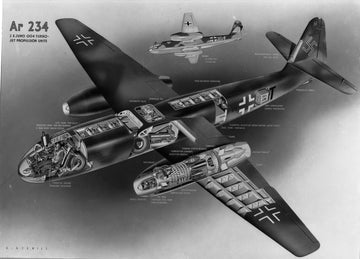The Arado Ar 234: The World's First Operational Jet Bomber and Its Legacy
The Arado Ar 234, a product of German engineering prowess during the waning years of World War II, holds a distinct place in aviation history as the world's first operational jet-powered bomber. Designed by Arado Flugzeugwerke, the Ar 234 symbolized a significant leap in aerial warfare technology, combining speed, innovative design, and versatility. Despite its limited deployment and minimal impact on the war's outcome, the Ar 234 remains a testament to the technological ambitions and challenges faced by the Luftwaffe in the final stages of the conflict.

Genesis and Development
The conceptualization of the Arado Ar 234 traces back to 1940, when the Reichsluftfahrtministerium (RLM), or German Air Ministry, issued a requirement for a fast reconnaissance aircraft capable of outpacing enemy fighters. Arado Flugzeugwerke responded with a design that would eventually evolve into the Ar 234. Led by chief designer Walter Blume, the development faced numerous hurdles, particularly concerning the jet engines, which were still in their infancy.
The aircraft was initially powered by two Junkers Jumo 004 turbojet engines—the same engines used in the renowned Messerschmitt Me 262 fighter. However, the engines’ unreliability and high fuel consumption posed significant challenges. The Ar 234’s design incorporated a slender fuselage and a high-mounted wing configuration, optimized for speed and altitude. The prototype's maiden flight took place on July 30, 1943, marking the beginning of a new era in military aviation.

Design Innovations and Technical Specifications
The Arado Ar 234 was a marvel of aerodynamic design and technological innovation. One of its most notable features was the use of a tricycle landing gear—an uncommon choice at the time—which improved stability during takeoff and landing. However, early prototypes lacked conventional landing gear and relied on a jettisonable takeoff trolley and retractable skids for landing, complicating ground operations and limiting its operational flexibility.
The aircraft’s streamlined fuselage housed a pressurized cockpit, providing the pilot with enhanced comfort and operational capability at high altitudes. The cockpit was fitted with a glazed nose, offering excellent visibility, and a basic autopilot system to aid in long reconnaissance missions. The Ar 234B, the most produced variant, was equipped with four BMW 003 engines, increasing its speed and range.
Performance-wise, the Ar 234 could achieve a top speed of approximately 742 km/h (461 mph) and an operational ceiling of 10,000 meters (32,800 feet). Its range was around 1,556 kilometers (967 miles), depending on the payload and fuel configuration. The bomber variant could carry up to 1,500 kilograms (3,300 pounds) of bombs, typically in an external fuselage-mounted configuration.

Operational History
The Arado Ar 234's operational debut occurred in late 1944, primarily in reconnaissance missions over Allied territories. Its superior speed allowed it to evade interception, providing the German High Command with valuable intelligence during a critical phase of the war. The reconnaissance variant, the Ar 234B-1, proved effective in photographing enemy positions and movements, contributing to tactical planning.
As a bomber, the Ar 234B-2 faced mixed results. Its high-speed bombing runs made it difficult for Allied forces to intercept, but its limited bomb load and lack of defensive armament reduced its overall impact. The aircraft participated in several notable missions, including attempts to disrupt the Allied supply lines during the Battle of the Bulge and attacks on the Ludendorff Bridge at Remagen in March 1945. Despite these efforts, the Ar 234’s influence on the broader strategic situation was negligible due to its late introduction and the dwindling resources of the Third Reich.
Challenges and Limitations
The Arado Ar 234’s advanced design was hampered by several critical limitations. The most pressing issue was the unreliability of its jet engines, which suffered from frequent mechanical failures and high fuel consumption. Maintenance demands were exacerbated by the scarcity of spare parts and trained personnel as Germany’s war situation deteriorated.
Furthermore, the aircraft's limited payload capacity and absence of defensive weaponry rendered it vulnerable if intercepted. Although its speed provided a degree of protection, the rapid advancement of Allied jet and propeller-driven aircraft gradually eroded this advantage. Additionally, the complexity of operating the takeoff trolleys and landing skids restricted the Ar 234’s operational flexibility, particularly in forward airfields and improvised runways.

Arado 234C - Quad engine late war variant
Legacy and Influence on Post-War Aviation
While the Arado Ar 234's direct impact on World War II was limited, its legacy in the evolution of military aviation is profound. As the first operational jet bomber, it paved the way for future developments in high-speed, high-altitude bombing techniques. The lessons learned from its design and operational deployment influenced both Allied and Soviet post-war jet bomber programs.
Captured Ar 234s were extensively studied by Allied engineers and aviation experts, contributing to the advancement of jet technology in the post-war period. The insights gained from the Ar 234’s performance and engineering were instrumental in the development of subsequent jet-powered reconnaissance and bomber aircraft during the Cold War.
In conclusion, the Arado Ar 234 remains a symbol of both the technological ambitions and the desperate measures of Nazi Germany during World War II. Its innovative design and groundbreaking use of jet propulsion mark it as a milestone in aviation history, despite its operational shortcomings and limited wartime success. The Ar 234's legacy endures as a testament to the rapid advancements in aerospace engineering during one of history's most tumultuous periods.
